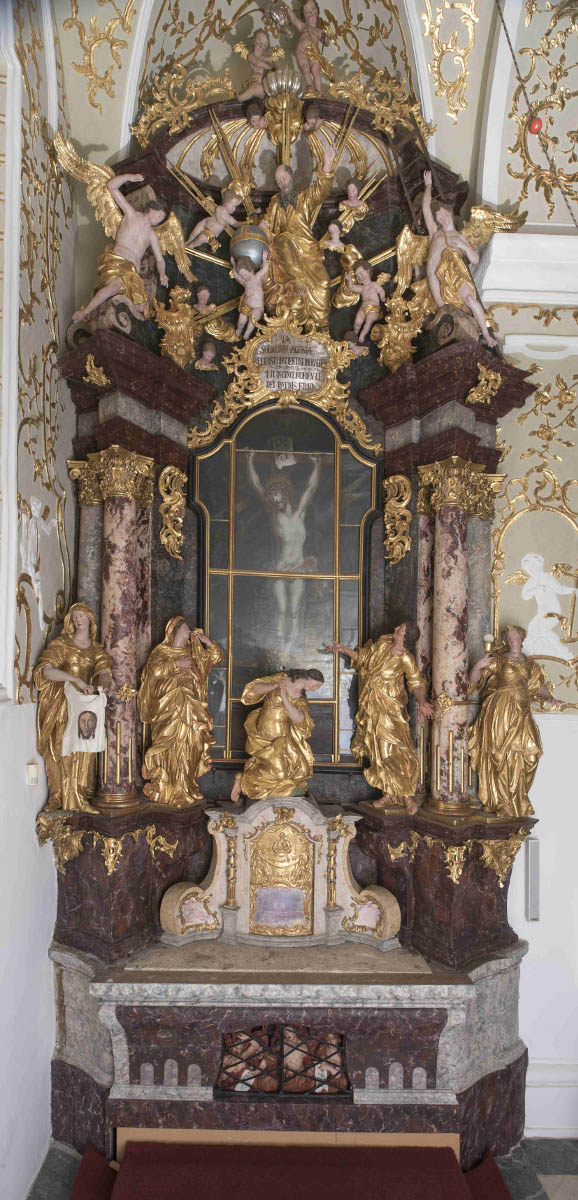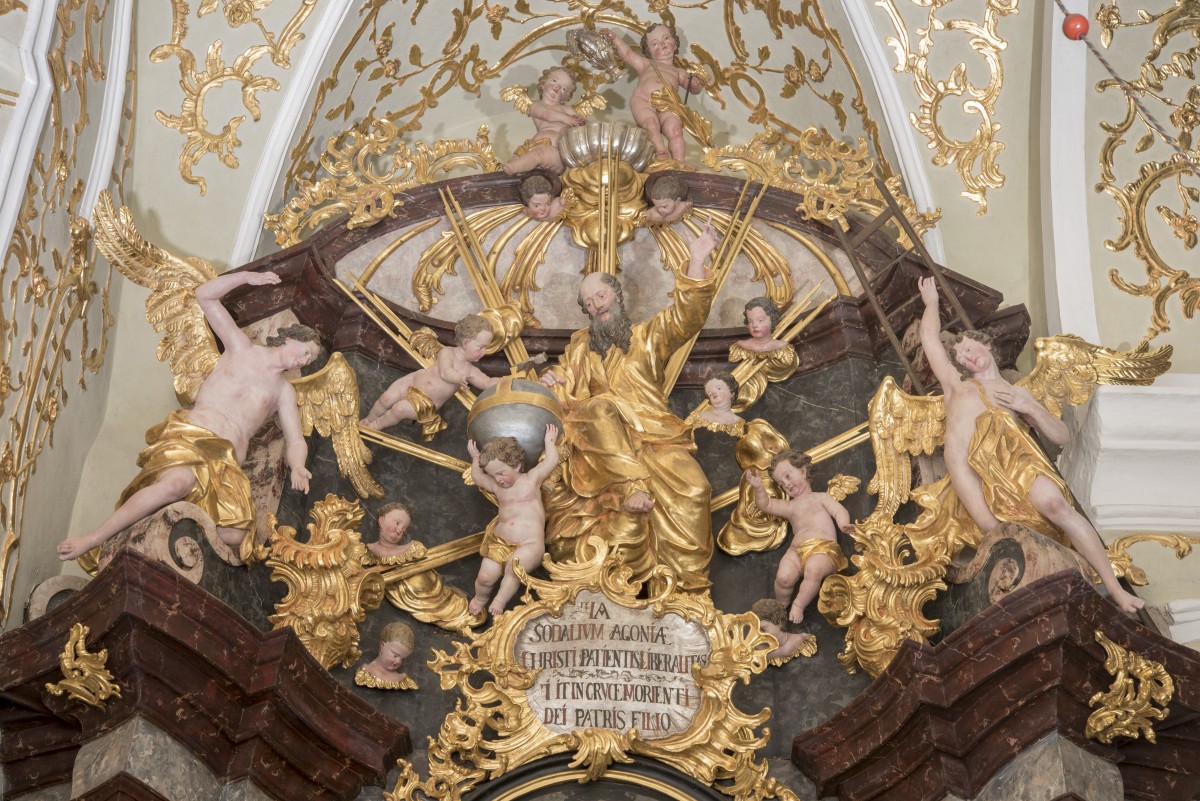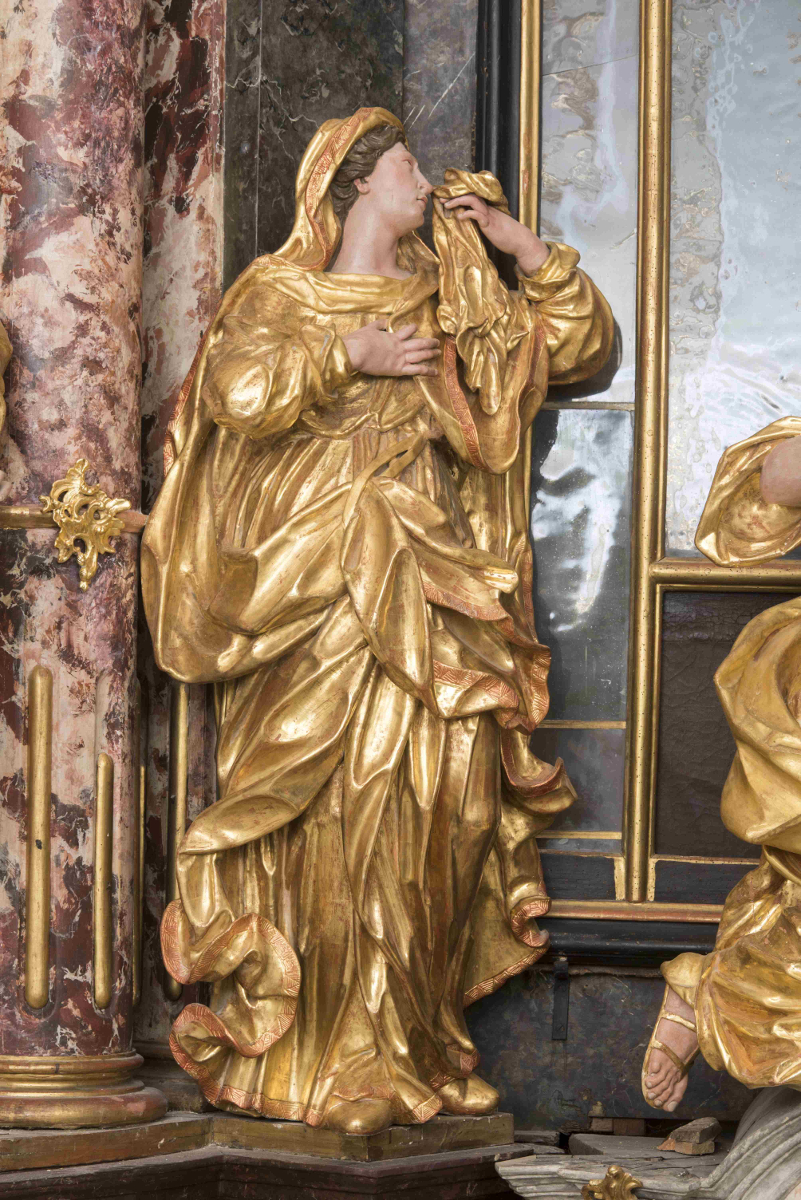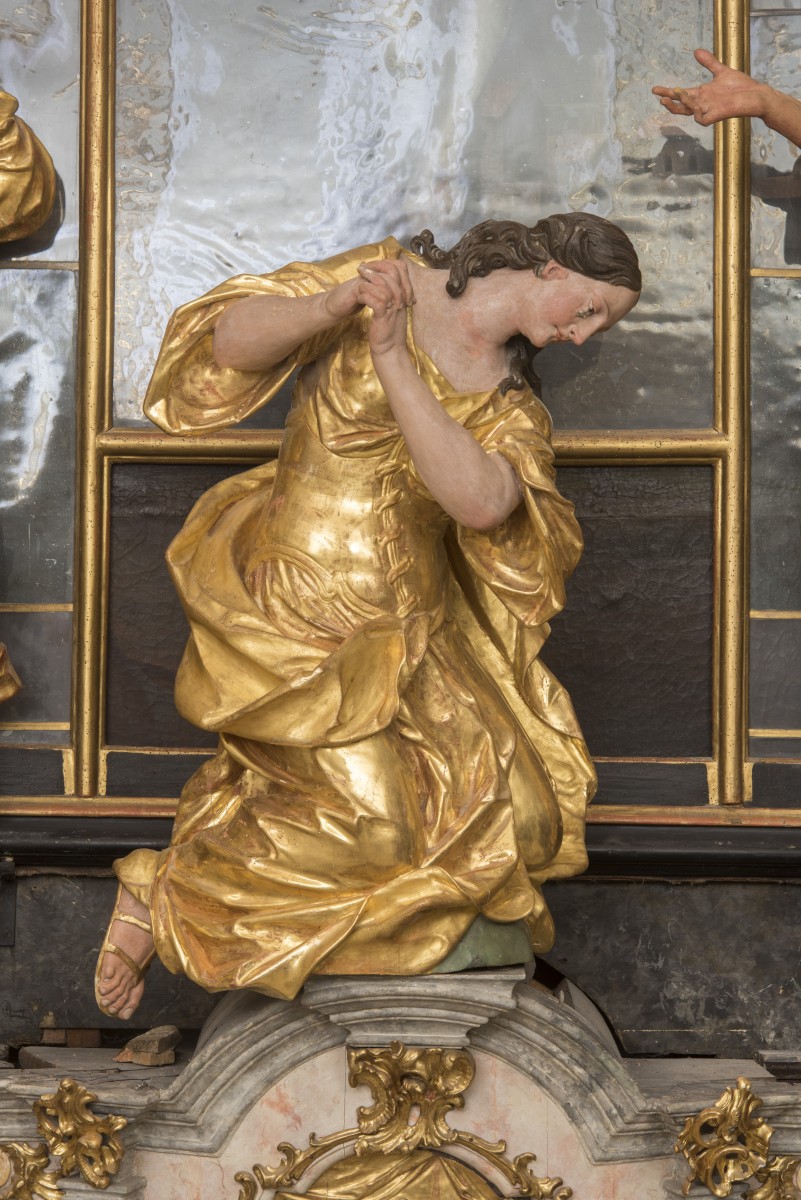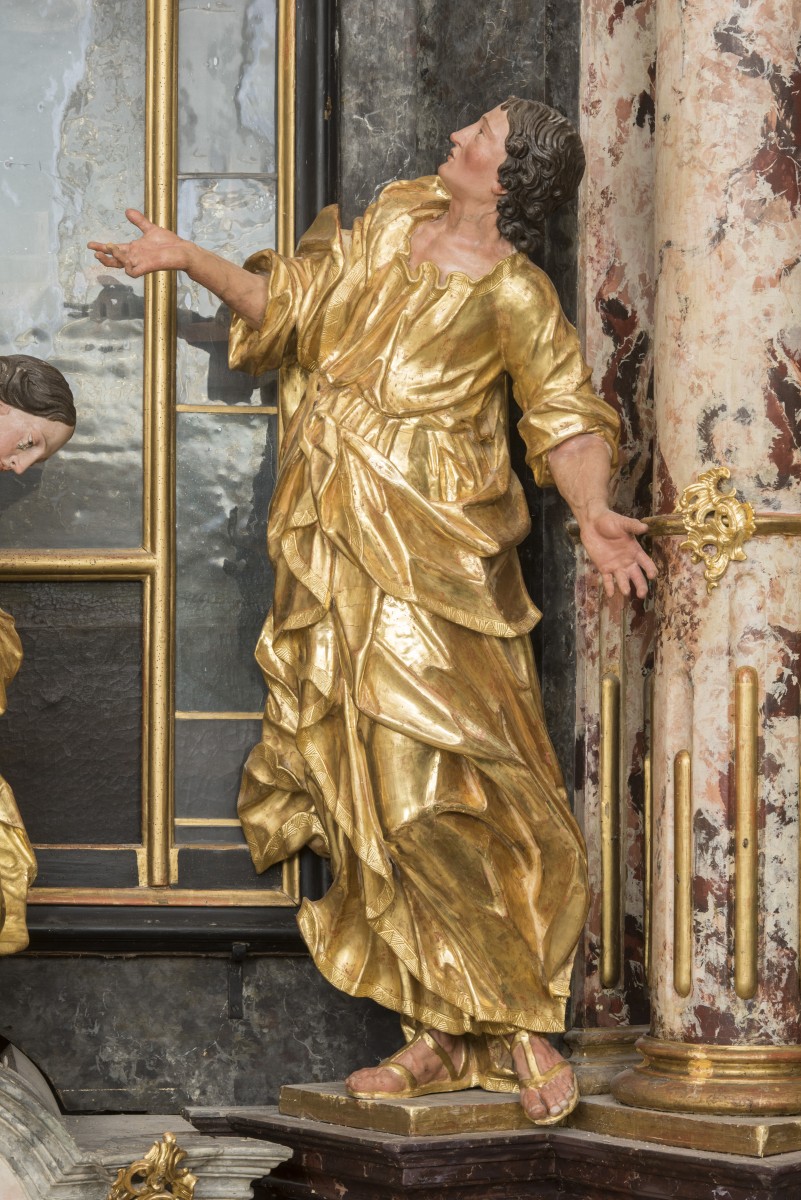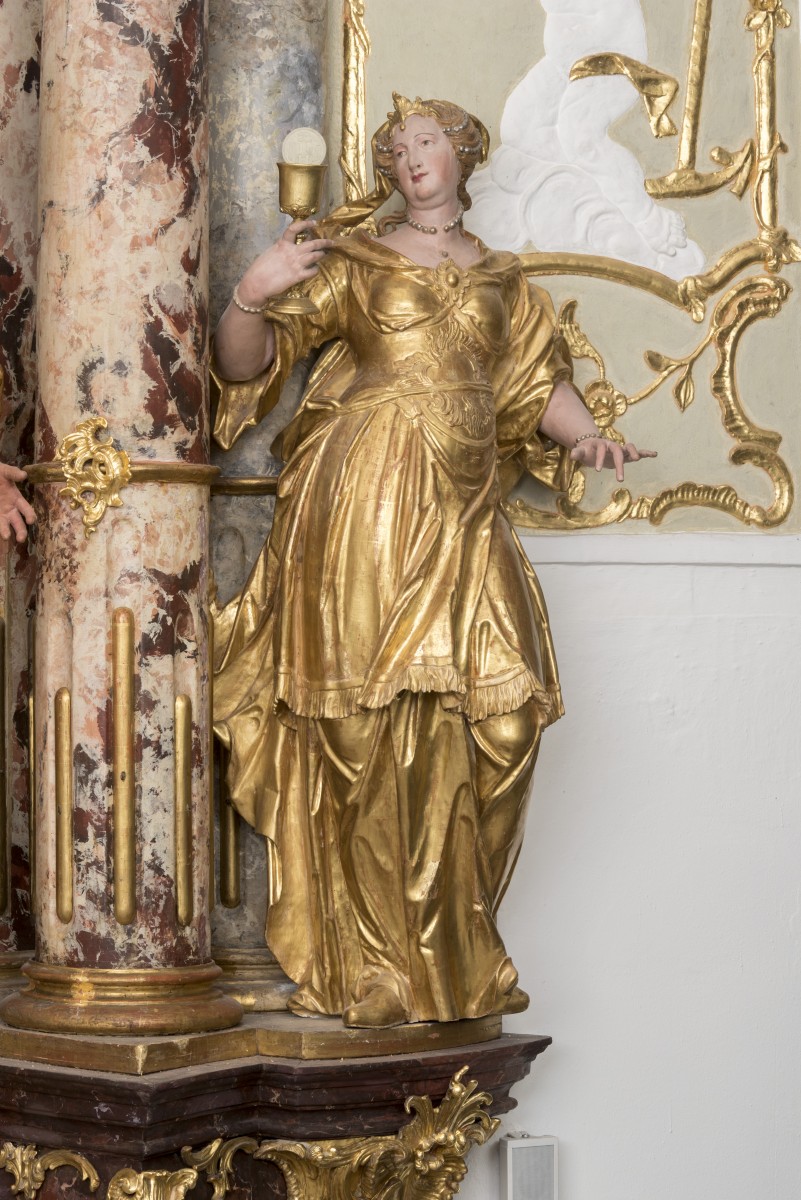Location
Croatia, Varaždin County, Varaždin
Cathedral of the Assumption of the Blessed Virgin Mary (Katedrala Uznesenja Blažene Djevice Marije)
Artwork
Left Side Altar of the Holy Cross in Varaždin Cathedral
Type
Side altar
Dimensions
Height: 780 cm, width: 340 cm, depth: 110 cm
Inscriptions
- pIa / soDaLIVM agonIæ / ChrIstI patIentIs LiberaLItas / .I.It In CrVCe MorIentI / DeI patrIs fILIo (the chronogram in the cartouche marks the year 1764)
- ALTARE / PRIVILEGIA/TUM (formerly in the layer above Ins. 1, now removed)
- Smilujte se / Smilujte / se meni / Prijatelji / moji. (inscription in the hand of the soul from the Purgatory, maybe from 1900)
- O blagi / Gospo-/dine / Jezuse, / daruj pokoj / vječni Amen (inscription in the hand of the soul in Purgatory, maybe from 1900)
Critical History
In the centre of the retable is an old painting The Crucified Christ by an unknown Austrian painter dated around 1678, moved from a previous altar.1 The altar was commissioned in 1762 by the Fraternity of the Passion and Death of Christ,2 along with the stucco and the wrought fence in the chapel. In 1764 the new altar was mentioned as being recently erected.3 The date of completion can be read on the chronogram (Ins. 1). The works were completed for the cost of 1600 florins.4 Scholars connect the sculptural work to the workshops of Veit Königer5 or Philipp Jakob Straub.6 Based on analogy with the pulpit from 1761, Franz Karcher was responsible for the polychromy.7 The painting was covered in crystal glass in 1737.8 The altar and the painting were revarnished in 1900.9 The tabernacle dates from the same period, and the relief on the front shows stylistic resemblance to the relief on the pulpit in the same church. In 1764 it was recorded to be covered by marble and gold from the outside, and by mirrors from the inside.10
Components
- Carpentry
- Author: Philipp Jakob Straub (Wiesensteig 1706 – Graz 1774)
- Completed: 1762 – 1764
- Patron(s): Christian fraternity, Christian fraternity
- Technique(s): sawing, wood carving
- Material(s): wood
- Sculpture
- Sculpture and ornamentation
- Author: Philipp Jakob Straub (Wiesensteig 1706 – Graz 1774)
- Completed: 1762 – 1764
- Patron(s): Christian fraternity, Christian fraternity
- Technique(s): wood carving
- Material(s): wood
- Painting
- The Crucifixion of Christ
- Completed: 1678 – 1680
- Patron(s): Christian fraternity, Christian fraternity
- Technique(s): oil on canvas
- Polychromy
- Author: Franz Karcher
- Completed: 1762 – 1764
- Patron(s): Christian fraternity, Christian fraternity
- Technique(s): oil gilding, tempera, water gilding
- Material(s): gold leaf, red bole, silver leaf, yellow bole
Comment
The gilding was partially repaired by imitation gold and the inscriptions were repainted. The altar was revarnished, but never widely repolychromed.
Conservation-restoration
- 1991–2016
Strategy: removing dirt, removing partial repairs, removing varnish
Approach to the presentation of losses
Reintegration of lacunae – mimetic: total
Reconstruction of losses: total
Materials: Bologna chalk, bone black, brown ochre, caput mortuum, ethyl alcohol, gold leaf, gold powder, limewood, Paraloid B-72, PVA adhesive, rabbit-skin glue, red bole, red ochre, sienna, silver leaf, terra pozzuoli, titan white, umber, yellow bole, yellow ochre
Treatment Description
Restoration began in 1991–1992 when several sculptures were prepared for the exhibition The Jesuit Heritage in Croatia (supervisor Đuro Šimičić).11 The academic painter Radovan Pavlek removed the yellowed varnish from the retable. Later conservation was performed from 2008 until 2016 at the Croatian Conservation Institute, supervised by Đuro Šimičić and Danuta Misiuda.12 The altar has never been completely repolychromed, only subsequently added layers of varnish (shellac) and partial repairs (imitation of gilding), which have been removed.
Images
- Altar of the Holy Cross in the Varaždin Cathedral (Croatian Conservation Institute Photo Archive, photo by Jovan Kliska, 2017)
- Altar of the Holy Cross, detail (Croatian Conservation Institute Photo Archive, photo by Jovan Kliska, 2017)
- Sculpture of the Virgin Mary (Croatian Conservation Institute Photo Archive, photo by Jovan Kliska, 2017)
- Sculpture of Mary Magdalene (Croatian Conservation Institute Photo Archive, photo by Jovan Kliska, 2017)
- Sculpture of St John the Evangelist (Croatian Conservation Institute Photo Archive, photo by Jovan Kliska, 2017)
- Sculpture of St Barbara (Croatian Conservation Institute Photo Archive, photo by Jovan Kliska, 2017)
Catalogue entry prepared by Ksenija Škarić and Martina Ožanić
Recommended citation: Ksenija Škarić and Martina Ožanić, Left Side Altar of the Holy Cross in Varaždin Cathedral, in: TrArS – Tracing the Art of the Straub Family, 2018, (accessed 24/10/2025) URL
